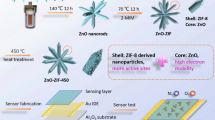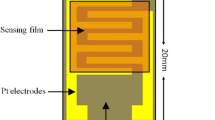Abstract
Automobile exhaust gas emissions are causing serious damage to urban air quality in and around major cities of the world, which demands continuous monitoring of exhaust emissions. The chief components of automobile exhaust include carbon monoxide (CO), nitrogen oxides (NOx), and hydrocarbons. Indium zirconate (InZrOx) and gold/indium zirconate (Au/InZrOx) composite nanopowders are believed to be interesting materials to detect these substances. To this end, characterization and gas sensing properties of InZrOx and Au/InZrOx composite nanopowders are discussed. InZrOx nanoparticles with In/Zr atomic ratio of 1.00 (±0.05) are synthesized via pH-controlled co-precipitation of In and Zr salts in aqueous ammonia. Gold (Au) nanoparticles are subsequently deposited on InZrOx using an in situ sacrificial Au electrolysis procedure. The products are characterized by scanning electron microscopy (SEM) and X-ray photoelectron spectroscopy (XPS). The gas sensing performance of Au/InZrOx composite nanopowder is studied by depositing a thick powder film on interdigitated electrode structures patterned on SiC substrate to facilitate high temperature operation. The resistivity of the Au/InZrOx layer is the sensor signal, and the sensors could be operated at 500–600 °C, which is a suitable temperature range for engine exhaust measurements. The control sensing measurements reveal that Au/InZrOx composite nanopowder exhibits higher response towards 2–20 % O2 gas as compared to pristine InZrOx nanoparticles. Further studies show that when applied to exhaust gases such as CO and nitric oxide (NO), the response of Au/InZrOx sensors is significantly higher towards NO in this temperature range. Thus, sensor performance characteristics of Au/InZrOx composite nanopowder are promising in terms of their applications in automobile exhaust emission control.







Similar content being viewed by others
References
Kim I-D, Rothschild A, Tuller HL (2013) Advances and new directions in gas-sensing devices. Acta Mater 61:974–1000
Riegel J, Neumann H, Wiedenmann H-M (2002) Exhaust gas sensors for automotive emission control. Solid State Ionics 152:783–800
Moos R (2005) A brief overview on automotive exhaust gas sensors based on electroceramics. Int J Appl Ceram Technol 2:401–413
Moos R (2010) Catalysts as sensors—a promising novel approach in automotive exhaust gas aftertreatment. Sensors 10:6773–6787
Moos R (2011) New approaches for exhaust gas sensing. In: Fleischer M, Lehmann M (eds) Solid state gas sens. - Ind. Appl. Springer, Berlin, pp 173–188
Afzal A, Cioffi N, Sabbatini L, Torsi L (2012) NOx sensors based on semiconducting metal oxide nanostructures: progress and perspectives. Sensors Actuators B Chem 171–172:25–42
Lutic D, Strand M, Lloyd-Spetz A, Buchholt K, Ieva E, Käll P-O, Sanati M (2007) Catalytic properties of oxide nanoparticles applied in gas sensors. Top Catal 45:105–109
Barsan N, Koziej D, Weimar U (2007) Metal oxide-based gas sensor research: how to? Sensors Actuators B Chem 121:18–35
Du N, Zhang H, Chen BD, Ma XY, Liu ZH, Wu JB, Yang DR (2007) Porous indium oxide nanotubes: layer-by-layer assembly on carbon-nanotube templates and application for room-temperature NH3 gas sensors. Adv Mater 19:1641–1645
Liu X, Zhang J, Wang L, Yang T, Guo X, Wu S, Wang S (2011) 3D hierarchically porous ZnO structures and their functionalization by Au nanoparticles for gas sensors. J Mater Chem 21:349–356
Fleischer M, Lehmann M (2012) Solid State Gas Sensors—Industrial Application. Springer Berlin Heidelberg, Berlin
Huotari J, Lappalainen J, Puustinen J, Lloyd Spetz A (2013) Gas sensing properties of pulsed laser deposited vanadium oxide thin films with various crystal structures. Sensors Actuators B Chem 187:386–394
Sadek AZ, Choopun S, Wlodarski W, Ippolito SJ, Kalantar-Zadeh K (2007) Characterization of ZnO nanobelt-based gas sensor for H2, NO2, and hydrocarbon sensing. IEEE Sensors J 7:919–924
Cho H-C, Takase S, Song J-H, Shimizu Y (2013) Sensing behavior of solid-state impedancemetric NOx sensor using solid electrolyte transducer and oxide receptor. Sensors Actuators B Chem 187:94–98
Cui L, Han F, Dai W, Murray EP (2014) Influence of microstructure on the sensing behavior of NOx exhaust gas sensors. J Electrochem Soc 161:B34–B38
Maskell WC, Brett DJL, Brandon NP (2014) Thick-film amperometric zirconia oxygen sensors: influence of cobalt oxide as a sintering aid. Meas Sci Technol 25:065104
Sowti khiabani P, Marzbanrad E, Hassani H, Raissi B (2013) Fast response NO2 gas sensor based on In2O3 nanoparticles. J Am Ceram Soc 96:2493–2498
Kim B-J, Song I-G, Kim J-S (2014) In2O3-based micro gas sensor for detecting NO x gases. Electron Mater Lett 10:509–513
Yang W, Wan P, Zhou X, Hu J, Guan Y, Feng L (2014) Additive-free synthesis of In2O3 cubes embedded into graphene sheets and their enhanced NO2 sensing performance at room temperature. ACS Appl Mater Interfaces 6:21093–21100
Ivanovskaya MI, Ovodok EA, Kotsikau DA (2012) Interaction of carbon monoxide with In2O3 and In2O3-Au nanocomposite. J Appl Spectrosc 78:842–847
Karwacki CJ, Ganesh P, Kent PRC, Gordon WO, Peterson GW, Niu JJ, Gogotsi Y (2013) Structure–activity relationship of Au/ZrO2 catalyst on formation of hydroxyl groups and its influence on CO oxidation. J Mater Chem A 1:6051–6062
Li X, Liu J, Guo H, Zhou X, Wang C, Sun P, Hu X, Lu G (2014) Au@In2O3 core–shell composites: a metal–semiconductor heterostructure for gas sensing applications. RSC Adv 5:545–551
Afzal A, Di Franco C, Mesto E, Ditaranto N, Cioffi N, Scordari F, Scamarcio G, Torsi L (2015) Au/In2O3 and Au/ZrO2 composite nanoparticles via in situ sacrificial gold electrolysis. Mater Express 5:171–179
Reetz MT, Helbig W (1994) Size-selective synthesis of nanostructured transition metal clusters. J Am Chem Soc 116:7401–7402
Reetz MT, Quaiser SA (1995) A new method for the preparation of nanostructured metal clusters. Angew Chem Int Ed Engl 34:2240–2241
Thermo Avantage (2012) Avantage data system. Thermo Fisher Scientific Inc
Pilolli R, Ditaranto N, Franco C, Palmisano F, Cioffi N (2012) Thermally annealed gold nanoparticles for surface-assisted laser desorption ionisation—mass spectrometry of low molecular weight analytes. Anal Bioanal Chem 404:1703–1711
Pearce R, Iakimov T, Andersson M, Hultman L, Spetz AL, Yakimova R (2011) Epitaxially grown graphene based gas sensors for ultra sensitive NO2 detection. Sensors Actuators B Chem 155:451–455
Stefánsson A (2002) The stability and stoichiometry of gold(I) and silver(I) complexes in hydrothermal solutions. Swiss Federal Institute of Technology, Zurich
Huang Y, Li D, Li J (2004) β-Cyclodextrin controlled assembling nanostructures from gold nanoparticles to gold nanowires. Chem Phys Lett 389:14–18
Monopoli A, Afzal A, di Franco C, Ditaranto N, Cioffi N, Nacci A, Cotugno P, Torsi L (2014) Design of novel indium oxide supported gold nanocatalysts and their application in homocoupling of arylboronic acids. J Mol Catal Chem 386:101–107
Yang H, Wang S, Yang Y (2012) Zn-doped In2O3 nanostructures: preparation, structure and gas-sensing properties. CrystEngComm 14:1135–1142
Rich R (2007) Inorganic reactions in water. Springer
Lin AWC, Armstrong NR, Kuwana T (1977) X-ray photoelectron/Auger electron spectroscopic studies of tin and indium metal foils and oxides. Anal Chem 49:1228–1235
Fabris S, Paxton AT, Finnis MW (2002) A stabilization mechanism of zirconia based on oxygen vacancies only. Acta Mater 50:5171–5178
Agoston P, Albe K, Nieminen RM, Puska MJ (2009) Intrinsic n-type behavior in transparent conducting oxides: a comparative hybrid-functional study of In2O3, SnO2, and ZnO. Phys Rev Lett 103:245501
Mahmood Q, Afzal A, Siddiqi HM, Habib A (2013) Sol–gel synthesis of tetragonal ZrO2 nanoparticles stabilized by crystallite size and oxygen vacancies. J Sol-Gel Sci Technol 67:670–674
Borisenko VE, Gaponenko SV, Gurin VS (2011) Physics, chemistry and applications of nanostructures: proceedings of the international conference nanomeeting—2011: reviews and short notes: Minsk, Belarus, 26-29 May 2009. World Scientific
Ye J, Liu C, Mei D, Ge Q (2013) Active oxygen vacancy site for methanol synthesis from CO2 hydrogenation on In2O3(110): a DFT study. ACS Catal 3:1296–1306
Gan J, Lu X, Wu J, Xie S, Zhai T, Yu M, Zhang Z, Mao Y, Wang SCI, Shen Y, Tong Y (2013) Oxygen vacancies promoting photoelectrochemical performance of In2O3 nanocubes. Sci Rep 3:Art. No. 1021
Cioffi N, Colaianni L, Ieva E, Pilolli R, Ditaranto N, Angione MD, Cotrone S, Buchholt K, Spetz AL, Sabbatini L, Torsi L (2011) Electrosynthesis and characterization of gold nanoparticles for electronic capacitance sensing of pollutants. Electrochim Acta 56:3713–3720
Baltrus JP, Ohodnicki PR, Joy NA, Carpenter MA (2014) Examination of charge transfer in Au/YSZ for high-temperature optical gas sensing. Appl Surf Sci 313:19–25
Acknowledgments
This manuscript is designed for the special issue devoted to the anniversary of Professor M. A. Vorotyntsev. Authors join the Editors in celebrating this important occasion and the outstanding achievements of Professor Vorotyntsev.
Authors gratefully acknowledge the Apulian Technological District on Mechatronics (MEDIS) and the Italian Ministero dell’Istruzione, dell’Universita e della Ricerca (MIUR), PON program 2007–2013 for financial support.
Author information
Authors and Affiliations
Corresponding authors
Electronic supplementary material
Below is the link to the electronic supplementary material.
ESM 1
(DOCX 122 kb)
Rights and permissions
About this article
Cite this article
Afzal, A., Andersson, M., Di Franco, C. et al. Electrochemical deposition of gold on indium zirconate (InZrOx with In/Zr atomic ratio 1.0) for high temperature automobile exhaust gas sensors. J Solid State Electrochem 19, 2859–2868 (2015). https://doi.org/10.1007/s10008-015-2900-1
Received:
Revised:
Accepted:
Published:
Issue Date:
DOI: https://doi.org/10.1007/s10008-015-2900-1




